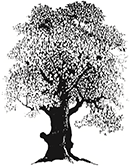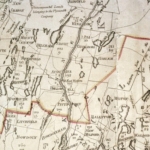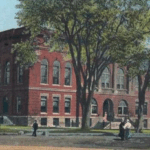Up and Down the Kennebec Valley: Doctors Pulsifer
 by Mary Grow
by Mary Grow
While wondering what new subject might keep readers – and writer — interested, your writer glanced at random pages in randomly-chosen history books. A warning: what she found does not remain in the central Kennebec Valley.
Her eyes fell on Dr. Nathan Goldsmith Howard Pulsifer.
Who could resist a name like that?
The man was a Waterville medical practitioner in the second half of the 19th century. As an added attraction, Dr. N. G. H. Pulsifer (as some historians call him) was the son of a doctor; brother of (at least) two doctors; and father of two more doctors.
FamilySearch’s analysis found that “Nathan” is a Biblical name, which in Hebrew means “God has given.”
“Goldsmith” is English and means a person who works in/with gold.
“Howard” is an English last – not first – name. FamilySearch says it was first spelled Haward, suggesting it was originally two Scandinavian words that meant “high guardian.”
“Pulsifer” is English, perhaps a variant of “Percival.”
An on-line genealogy says Pulsifer (Pulsever, Pulcifer, and other spellings) is a French Protestant name.
This source identifies the first Pulsifer in North America as John, who came to Gloucester, Massachusetts, in 1680. John’s great-grandson, David, moved to Poland, Maine (southwest of Lewiston), and fathered Jonathan Pulsifer, born about 1770. Jonathan and his wife, Polly Rust, were parents of Dr. Moses Rust Pulsifer, who was the father of Dr. Nathan Goldsmith Howard Pulsifer.
Moses Pulsifer was born in Poland, on Sept. 10, 1799. He attended district schools and studied medicine (no details). Another on-line source says, without explaining why, that he and his family moved to Mt. Desert Island in 1823. There, according to the on-line genealogy, he practiced in Eden (renamed Bar Harbor in March 1918) and the mainland towns of Sullivan and Ellsworth.
In 1819, Pulsifer married Mary Strout Dunn, born May 30, 1801, in Poland. She was the oldest of 13 children (of whom one died in infancy and two in their teens). Mary and Moses had three daughters (Find a Grave) or six daughters (FamilySearch) and seven sons, born between 1820 and 1842.
Mary died March 11, 1850. Her widower, the genealogy says, remarried and had two more children, a daughter who married a doctor in Old Town, Maine, and a son who became a farmer in Corinna, Maine.
Moses died in Ellsworth, on Jan. 27, 1877, of pneumonia. He and his wife are buried in Auburn’s Oak Hill cemetery (Auburn is about 10 miles from their birthplace in Poland, about 130 miles from Ellsworth).
Find a Grave lists 24 Pulsifers in Oak Hill cemetery, including Moses and Mary and their son (N. G. H.’s brother) Dr. Horatio Brigham Pulsifer (of whom more later). Death dates range from 1848 to 1961.
* * * * * *
N. G. H. Pulsifer was Mary and Moses’ second son, born Jan. 24, 1824, in Eden. The genealogy says he was “educated in the common schools of Eden and Minot.” Henry Kingsbury wrote in his Kennebec County history that he was educated in “district schools and Gorham Academy” (Minot, near Lewiston, is about 160 miles southwest of Bar Harbor; Gorham, near Portland, is about another 40 miles south) “and graduated from Dartmouth Medical School in 1848.” (Frederick Charles Thayer, in his chapter on the medical profession in Whittemore’s history, dated his graduation 1847, as does the on-line genealogy.)
After briefly studying and working with his father and another doctor named N. C. Harris, N. G. H. established a practice at Fox Island, Maine (Vinalhaven and North Haven, in Penobscot Bay), the genealogy says.
In 1849, N. G. H. and his older brother, Major J. D. Pulsifer, caught gold fever. N. G. H.’s obituary says they joined a company that bought a sailing ship (other sources specify a barkentine named “Belgrade”) and made a stormy six-month trip around Cape Horn to California, with N. G. H. serving as ship’s doctor. Their search for gold brought “fair success.”
FamilySearch found (presumably from census records) that N. G. H. was living in Sutter, California, in 1850.
He came back to Ellsworth in 1851 and practiced homeopathy with his father; studied in New York and at Philadelphia’s Homeopathic Medical College, aka Hahnemann Medical College; and returned to Waterville in January 1852.
(Wikipedia terms homeopathy “a pseudoscientific system of alternative medicine,” based on German doctor Samuel Hahnemann’s 1796 theory. Practitioners “believe that a substance that causes symptoms of a disease in healthy people can cure similar symptoms in sick people.” “All relevant scientific knowledge about physics, chemistry, biochemistry and biology contradicts homeopathy,” Wikipedia says.)
(Hahnemann Medical College was founded in 1848 by three homeopathic doctors, per Wikipedia. By the late 1920s, the school had “dropped its homeopathic focus.”)
N. G. H. was a member of the American Homeopathic Society, the genealogy says (and a Republican and a Unitarian).
Thayer wrote that in Waterville, N. G. H. “at once built up a large practice.” The genealogy writer says he “ranked among the leaders in his profession for many years. He was held in the highest esteem by his fellow practitioners as well as by the families whom he served.”
The writer of his obituary praised his “fidelity to his patients and painstaking thoroughness as a physician” and “his sterling worth and strict integrity as a man.”
On Oct. 24, 1855, in Waterville, N. G. H. and Ann Cornelia Moor were married. They had two sons and two daughters: Nora Nellie Pulsifer (1856 – 1936); Cornelia Ann Pulsifer (1860 -1951); Dr. William Moor Pulsifer (Aug. 18, 1863 – Nov. 14, 1915) and Dr. Ralph Howard Pulsifer (Aug. 19, 1865 – 1926).
N. G. H. was not only a doctor. Kingsbury wrote, in 1892, that “Dr. [N. G. H.] Pulsifer has been devoting his attention to real estate operations and banking for the past twenty years.” Thayer praised N. G. H.’s financial judgment.
Horatio Bates’ chapter on Waterville banks lists, among others, People’s National Bank, which received a federal charter on March 15, 1865. N. G. H. was a director and vice-president and then its second president, serving from 1882 until he died in 1893.
N. G. H. is also listed among the 26 charter members of Waterville Savings Bank (1869). The genealogy mentions investments in real estate.
He was a member of the five-man building committee that oversaw construction of Waterville’s “beautiful north grammar school building,” dedicated Feb. 28, 1888. On-line photos show a two-story brick building on a basement, with large rectangular windows and arched doorways. An old map shows a schoolhouse in the southeast corner of the intersection of Pleasant and North streets.
N. G. H. died on December 3, 1893, in Waterville, at the age of 69. Ann died July 5, 1919, also in Waterville. Both are buried in the city’s Pine Grove cemetery.
* * * * * *
N. G. H. and Ann’s older son, William Moor Pulsifer (born Aug. 18, 1863), graduated from Coburn in 1878 and Colby in 1882, Thayer said. He earned one M.D. from Harvard Medical School in 1887 and a second from Hahnemann in 1888 (or, the on-line genealogy says, took a post-graduate course there in 1890). He promptly established a practice in Skowhegan; returned to Waterville in 1892; and went back to Skowhegan in 1900. On Oct. 2, 1896, he married Helen G. Libby. He died in November, 1915, in Skowhegan.
His younger brother, Ralph Howard Pulsifer (born Aug. 19, 1865), followed the family tradition, graduating from Coburn in 1882 and Colby in 1886. His first medical degree was from Boston University, in 1880 (genealogy) or 1889 (Thayer), and he, too, earned a second M. D. from Hahnemann, in 1890.
This Dr. Pulsifer opened a practice in Waterville in November 1890 and after two years moved to Skowhegan. He married Grace Yeaton on Feb. 23, 1893; they had one son as of 1902. The Pulsifers moved back to Waterville in 1897, and in 1902, Thayer said, they lived in Vassalboro. Pulsifer died in 1926, in Belgrade or Waterville (sources disagree).
* * * * * *
Find a Grave identifies one other doctor in N. G. H.’s generation, his younger brother, Horatio Brigham (or Bridgham, Geni says) Pulsifer, born in Minot, Dec. 28, 1835, and died in Auburn April 7 or June 10, 1929, aged 93.
On Nov. 1, 1861, in Auburn, he married Augusta Ellen Roak, born in Auburn Jan. 21, 1838. They had three sons (plus three who died in infancy, according to FamilySearch) and a daughter; on-line sources identify none as a doctor. Augusta died in Auburn April 20, 1933, according to Find a Grave.
Geni gives N. G. H. a second doctor/brother, Thomas Pulsifer, born to Moses and Mary Pulsifer on April 2, 1842, in Poland. The website cites other sources that say Thomas Pulsifer entered Waterville (Colby) College in 1859, but left in 1861 and on Oct. 1 enlisted in the First Maine Cavalry.
During his military service, Pulsifer was taken prisoner in June 1863. Exchanged the next month, he remained in the army and was badly wounded on Aug. 6, 1864. He was discharged Nov. 25, 1864.
After studying medicine with his father for an unspecified time, in 1872 Thomas Pulsifer graduated from Hahnemann. The next year he opened a practice in Yarmouth, Massachusetts, on Cape Cod (“because Yarmouth was in need of a doctor,” an on-line site says).
On June 1, 1880, he married Annie Gorham (born Sept. 3, 1859, the same autumn her husband started college), in Yarmouth. Between April 1881 and April 1887, the couple had two daughters, Caroline and her sister who died in infancy, and one son.
Dr. Thomas Pulsifer died in 1912, aged 70, Geni says.
* * * * * *
The Historical Society of Old Yarmouth (Massachusetts) has on its website an illustrated memoir by Caroline (Pulsifer) Siebens (1881-1970), one of the society’s founders and the daughter of “town doctor Thomas B. Pulsifer.” The essay is titled “Horses and Buggies and a Donkey – oh my!”
Siebens talked about several family horses, starting with Lightfoot, “named for my father’s favorite mount in the Civil War. She was raised in Maine by my uncle, Dr Horatio Pulsifer, of Auburn.”
Lightfoot’s offspring included Brandywine and Marguerite. Siebens said people wondered why “a temperance advocate” would name a horse after two alcoholic drinks.
A friend of her father’s called Marguerite the “wild horse you keep in your barn.” A black and white photo of Siebens on Marguerite’s back, taken about 1896, shows an all-over dark brown horse.
Marguerite, and others, drew or carried Dr. Pulsifer on his rounds. Siebens said he usually used the family buggy; but sometimes, “to spare the horse but not himself,” he drove a light, two-wheeled gig that provided no support for his back.
On windy winter days, Siebens wrote, the doctor used, apparently in the buggy, what she called a cage, “a square coach-like affair that shut up tight but was unsuited to rapid transit. What one gained in protection from the cold was lost by the slow travel that kept one out in the severe weather for a much longer time.”
The doctor had a sleigh for travel over snow. Siebens wrote that “Sometimes in the worst weather Father rode horseback.”
Since his horses usually knew where they were going, the doctor could take a nap, she claimed – until his horse, too, “drowsed off” and wakened him by stopping.
On Sunday afternoons, Siebens and her brother enjoyed going on rounds with the doctor, “although it did involve a good deal of waiting while he visited patients.” Their very religious neighbors condoned the doctor doing errands of mercy on the Sabbath, but called the accompanying pleasure-riders Sabbath-breakers who would come to a bad end.
Main sources
Kingsbury, Henry D., ed., Illustrated History of Kennebec County Maine 1625-1892 (1892)
Whittemore, Rev. Edwin Carey, Centennial History of Waterville 1802-1902 (1902)
Websites, miscellaneous.
Responsible journalism is hard work!
It is also expensive!
If you enjoy reading The Town Line and the good news we bring you each week, would you consider a donation to help us continue the work we’re doing?
The Town Line is a 501(c)(3) nonprofit private foundation, and all donations are tax deductible under the Internal Revenue Service code.
To help, please visit our online donation page or mail a check payable to The Town Line, PO Box 89, South China, ME 04358. Your contribution is appreciated!




Leave a Reply
Want to join the discussion?Feel free to contribute!